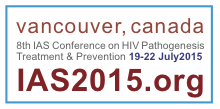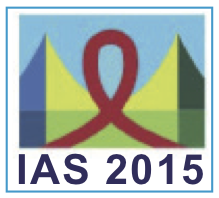Raltegravir for neonates will require a complicated dosing regimen
1 October 2015. Related: Conference reports, Pregnancy, Paediatric care.
A complex dosing regimen will be required to give raltegravir (RAL) to neonates according to data from the International Maternal, Paediatric, Adolescent, AIDS Clinical Trials (IMPAACT) Group presented at IAS 2015.
There are limited antiretrovirals with appropriate formulations and pharmacokinetic (PK) data to guide their use in neonates.
 RAL is approved for infants down to four weeks of age. A formulation of granules for oral suspension is available for this age group. A comprehensive development plan is ongoing with the IMPAACT Group that will inform dosing in neonates less than four weeks of age:
RAL is approved for infants down to four weeks of age. A formulation of granules for oral suspension is available for this age group. A comprehensive development plan is ongoing with the IMPAACT Group that will inform dosing in neonates less than four weeks of age:
- IMPAACT P1097 was conducted to look at washout PK in neonates born to mothers receiving RAL in late pregnancy. This study showed that RAL crosses the placenta well. There was variable and prolonged elimination of RAL in the first days of life compared with older infants and children. P1097 is now assessing washout PK in a cohort of low birth weight (including preterm) neonates.
- IMPAACT P1110 is an ongoing two-part PK and safety study of RAL in term neonates at high risk of vertical HIV infection, informed by P1097 results.
RAL has the potential for use in prophylaxis and treatment of neonates at high risk of vertical HIV infection. The drug is primarily metabolised by UGT1A1, which has low activity at birth but increases over the first weeks of life and will influence neonatal dosing.
IMPAACT P1110 aims to evaluate the PK and safety of RAL and find an appropriate dose for neonates and infants up to six weeks of age. The study has a two cohort adaptive design: PK data from cohort 1 are included in PK modelling to inform dosing in cohort 2. It is a phase I multicentre PK study of in full-term, HIV-exposed, high-risk neonates.
Cohort 1 participants received a single oral dose of RAL within 48 hours of birth added to standard of care antiretrovirals for PMTCT prophylaxis, and a second dose at 7-10 days old. The initial dose was 3 mg/kg and doses were adjusted as the study progressed. RAL-exposed infants born to mothers receiving the drug during pregnancy and delivery were excluded at the beginning of the study. Later their enrollment was permitted with a lower initial dose.
The investigators performed intensive PK sampling around the initial dose: pre-dose and 1-2 hours, 4-8 hours, 12 hours, 24 hours post-dose and a random sample at 3-4 days old. Sampling was at three time points around the second dose: pre-dose and 1-2 hours and 24 hours post-dose. A validated HPLC-MS-MS method with a lower limit of quantification of 22.5 nM was used to analyse the samples. Protocol specified exposure limits from non-compartmental analysis for each participant were: Cmax < 19.6 uM and AUC12 <63 uMxhr.
Cohort 1 comprised 13 neonates: 10 were born to mothers who did not receive RAL before delivery (RAL-naive) and 3 to mothers who received RAL before and during delivery (RAL-exposed). Neonates were 54% female with a median gestational age of 39.0 weeks (range 36.0 to 39.6) and birth weight of 3.02 kg (2.39 to 4.20). Evaluable initial dose and week 1 dose concentration data were available for 12/13 neonates.
The interim analysis of PK data from the first 6 RAL-naive neonates who received 3 mg/kg initial doses found none exceeded the Cmax upper limit but two exceeded the AUC12 upper limit. Following this analysis, the initial dose was reduced to 2 mg/kg for RAL-naive and 1.5 mg/kg for RAL-exposed neonates. Table 1 shows RAL PK parameters for cohort 1 following initial doses.
|
RAL dose |
Age at initial dose (hr) |
Cmax (uM) |
AUC12 (uM*hr) |
T1/2 (hrs) |
Tmax (hrs) |
C24h (uM) |
Vz/F (L/kg) |
CI/F (L/kg/hr) |
|---|---|---|---|---|---|---|---|---|
|
3mg/kg RAL- naive (n=6) |
17.2 (9.9-25.4) |
7.56 (4.51-11.96) |
66.3 (42.5-104.1) |
11.8 (7.9-15.7) |
6.5 (4.1-24.0) |
3.25 (1.49-8.22) |
0.56 (0.35-0.80) |
0.033 (0.021-0.053) |
|
2mg/kg RAL- naive (n=3) |
27.1 (24.2-33.1) |
7.66 (5.01-9.73) |
63.3 (39.2-99.0) |
17.2 (6.3-32.8) |
4.4 (4.3-4.7) |
1.81 (0.38-5.60) |
0.68 (0.43-0.86) |
0.074 (0.039-0.109) |
|
1.5mg/kg RAL-exposed (n=3) |
34.1 (22.8-44.9) |
3.31 (1.98-25.4) |
29.0 (17.5-78.0) |
8.7 (6.0-11.7) |
4.6 (1.8-11.0) |
0.95 (0.17-3.33) |
0.62 (0.32-1.31) |
0.049 (0.019-0.151) |
Geometric mean (range)
All neonates received 3 mg/kg for the second dose at 7-10 days old.
When the investigators looked at protocol specified exposure limits, all 12 evaluable neonates had a Cmax <19.6 uM. But, 3/6 infants who received 3 mg/kg; 2/3 infants who received 2 mg/kg; and 1/3 RAL-exposed infants who received 1.5 mg/kg initial dose exceeded AUC12 < 63 uMxhr.
RAL was well tolerated: one infant had a low absolute neutrophil count –considered possibly related to RAL – and none of the infants had elevated bilirubin that needed phototherapy.
The investigators then developed a population PK model including the initial cohort 1 PK data from 6 neonates and RAL concentration data from 24 infants and children ages 4 weeks to <2 years from IMPAACT P1066 – a phase 1/2, multi- centre, open-label, non-comparative intensive PK study in infants and children. They performed population modelling of the combined data set using NONMEM software.
This revealed a change in absorption rate from 16% of maximum at birth to 90% within 2 weeks. Clearance changed from almost nil to a maximum at approximately 6 months of age.
PK parameters including absorption and clearance were estimated and using this population model, simulations were run of various dosing regimens in the first 6 weeks of life.
In the final model the dosing regimen through 6 weeks of age that best met the following revised PK exposure targets (defined for safety and efficacy from recent studies in older infants, children and adults) was selected for use in cohort 2: Cmax <19.63 uM, Cmin>75nM, AUC12 (twice a day) <45 uM*hr and AUC24 (one a day) < 90 uM*hr.
Cohort 2 will begin enrolling RAL-naive neonates with the dose selected from the PK modelling and simulations: 1.5 mg/ kg once a day from birth to day 7, followed by 3 mg/kg twice a day until 4 weeks of age, then 6 mg/kg twice a day to age 6 weeks.
Additional PK data need to be obtained before RAL-exposed neonates are enrolled. The investigators noted that PK results for cohort 2 will be evaluated on a rolling basis and dosing adjusted based on these results.
Comment
The RAL development programme in collaboration with the IMPAACT newwork is excellent and will provide comprehensive data to inform dosing of young infants for both treatment and prophylaxis.
The current granules for the suspension formulation is complicated to administer and generic versions will need to be simpler to use in low- and middle-income countries.
Neonates exposed to RAL in utero might require a different dosing strategy and are also being studied in P1110.
Reference:
Clarke DF et al. Raltegravir (RAL) pharmacokinetics (PK) and safety in HIV-1 exposed neonates at high-risk of infection (IMPAACT P1110). 8th IAS Conference on HIV Pathogenesis, Treatment & Prevention.19-22 July 2015. Vancouver, BC, Canada. Poster abstract MOPEB196.
http://pag.ias2015.org/PAGMaterial/eposters/2856.pdf (PDF)


